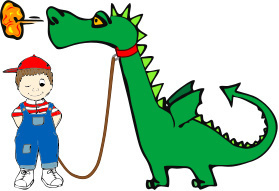Safe Fiction Is Dangerous (Or, A Review Of How To Train Your Dragon)
In light of the newest edition of the How To Train Your Dragon franchise, I thought running this article from the archives, a revised version of one first published here in June, 2014, might be interesting.
-
-
-
-
-
- *
-
-
-
-
 A few years ago I saw How to Train Your Dragon, the first installment of the How to Train Your Dragon series. The original is a wonderful, fun, well-executed, “safe” production.
A few years ago I saw How to Train Your Dragon, the first installment of the How to Train Your Dragon series. The original is a wonderful, fun, well-executed, “safe” production.
The main themes involved parent-child relationships and being true to oneself. Good things, for the most part. There was even a touching moment when the dad tells his son he’s proud of him.
I can see parents happily taking their children to see this movie and its sequel and feeling oh, so good about it. I know I felt uplifted when I walked out of the theater.
But here’s the thing. There are some side issues in How To Train Your Dragon that parents would be wise to think about and to discuss with their children, yet many may draw the false conclusion about the movie because of its happy ending and the reconciliation achieved—father with son and humans with dragons—that there are no ideas that may need to be questioned.
Here are some of the those issues, most not central to the main point.
- The decision not to kill a dragon (animal rights?)
- The existence of a “greater evil” than the one the humans saw (big government? big business? God? Satan? Who is the greater evil extorting the “dragons” today?)
- The attitude toward war. (Father: They’re killing hundreds of us. Son: But we’ve killed thousands of them. They’re just defending themselves.)
- Be true to yourself. (No matter that your true self is sinful?)
Am I saying How to Train Your Dragon is a bad movie and people should smash the DVD they bought and boycott the newest edition to the series? Hardly! I loved the first movie (and the second) and would recommend it to anyone. It’s family friendly, but it’s artistic, too. At times I thought I was seeing an animated version of Avatar (an animation of an animation—now if that doesn’t say something about the digital revolution).
What I am saying is that “safe” fiction is the most dangerous kind because people are disarmed, no longer alert to possible ideas that may foster a false worldview.
Ideas, of themselves, are not dangerous. I could, and did, listen to the late Christopher Hitchens, an atheist, in a debate about the existence of God, and was unaffected by his worldview because I was alert to his worldview.
Ideas that float in under the radar, however, are another thing. They enter our minds unchallenged, co-exist with the truth, and someday, after they’ve been fortified, may even challenge the truth to a shootout.
For the last thirty years at least, broadcast media as well as print media has taken this “under the radar” approach as a means to introduce a shift in worldview through “safe” stories. In fact, stories like those depicted in Glee and other “harmless” TV programs validated a belief and lifestyle that contradicts Scripture.
But the reality is, “safe” Christian fiction is no more safe than the secular media brand of safe. Pornography, for example, is now accepted by the secular media as normal, so “good, family-friendly” programs, not surprisingly, may include instance of involvement with pornography.
Sadly, the same is true with the Christian media. For example, I read one book put out by a Christian imprint that was all about lust. However, the heroine refused to marry the hero (because he wasn’t a Christian), but she didn’t refuse his kisses and didn’t stop dwelling on them or longing for them or becoming aroused by them. The story came to one titillating climax after another (pun intended). But it was safe since it had no bad words and no bedroom scenes.
 That book purposefully stretched the normal boundaries (the author called it “edgy”). What about those stories that are in the Christian fiction sweet spot, Amish romance? Does anyone know or care how Christian the Amish actually are? Are these books addressing legalism? (I’m asking, because I haven’t read any.) Church divisions? (Amish churches have divided over whether a woman’s dress must be double-breasted or not, whether or not a hook-and-eye is acceptable, and many other such particulars.) Or is there an underlying assumption that whatever the Amish do is good because of their safe externals?
That book purposefully stretched the normal boundaries (the author called it “edgy”). What about those stories that are in the Christian fiction sweet spot, Amish romance? Does anyone know or care how Christian the Amish actually are? Are these books addressing legalism? (I’m asking, because I haven’t read any.) Church divisions? (Amish churches have divided over whether a woman’s dress must be double-breasted or not, whether or not a hook-and-eye is acceptable, and many other such particulars.) Or is there an underlying assumption that whatever the Amish do is good because of their safe externals?
More importantly, are readers asking questions about the pastoral culture they lose themselves in? Or are we letting our guard down? Because these stories are about a group of Christians. And Christian are writing them, Christian companies are publishing them, and Christian bookstores are selling them.
As I see it, if “safe” fiction makes us drop our guard, then it is the most dangerous fiction of all.












































That last line is partly why I overanalyze and question like crazy. 😛 Not just with fiction, but everything in life. Though I have to do that twice as much as everyone else because otherwise I get too careless.
After meeting some folks who left the Amish church in our area (actually, who were excommunicated for believing in Jesus Christ as their Savior) I had to stop reading Amish fiction… What I was hearing from my neighbors and what I was reading just weren’t lining up. (To be clear, I’m not saying that “all Amish are not Christians.” There can be as many differences among Amish bishoprics as there are between Presbyterian denominations.)